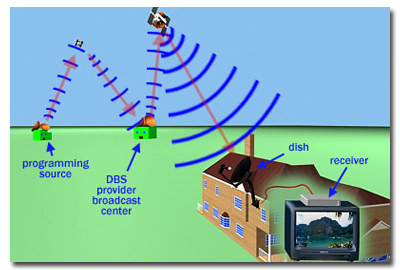|
|
 |
Knowledge Is Key
For Intelligent Decisions
Satellite Logic is a leading,
authoritative source of information in
the Satellite Industry. Located in the
heart of the Silicon Valley, Satellite
Logic provides one of the most
valuable and comprehensive
knowledge bases on the Satellite
market! This is a primary Worldwide
information center which enables our
clients to analyze, evaluate, inquire
and select their best tailored
solutions. Our company sets the
industry standards for targeted
buying leads, reflecting a dramatic
advance over traditional marketing
solutions.
|
|
|
 |

Satellite TV signals have a pretty long way to go before they appear on
your TV screen in the shape of your favorite TV program. Since satellite
TV signals contain such high-quality digital data, it's actually impossible
to transmit them without compression. The meaning of compression is
that the unnecessary or repetitive information is removed from the signal
before it is transmitted. The signal is reconstructed after transmission.
There are several standards of signal compression. Satellite TV uses a
special type of video file compression standardized by the Moving Picture
Experts Group (MPEG). With MPEG compression, the provider is able to
transmit significantly more channels. There are currently five of these
MPEG standards, each serving a different purpose.
DirecTV and DISH Network, the two major satellite TV providers in the
United States based their compression on MPEG-2. Today it is still used
to store movies on DVDs and for digital cable television (DTV). With
MPEG-2, the TV provider can reduce the 270-Mbps stream to about 5 or
10 Mbps (depending on the type of programming).
But these days DirecTV and DISH Network use MPEG-4 compression.
Because MPEG-4 was originally designed for streaming video in small-
screen media like computers, it can encode more efficiently and provide
a greater bandwidth than MPEG-2. MPEG-2 remains the official standard
for digital TV compression, but it is better equipped to analyze static
images, like those you see on a talk show or newscast dynamic images.
MPEG-4 can produce a better picture of dynamic images through use of
spatial (space) and temporal (time) compression. This is why satellite TV
using MPEG-4 compression provides high definition of quickly-moving
objects that constantly change place and direction on the screen, like in
a basketball game.

How does it work? At the broadcast center, the high-quality digital
stream of video goes through an MPEG encoder, which converts the
programming to MPEG-4 video of the correct size and format for the
satellite receiver in your house.
Encoding works in conjunction with compression to analyze each video
frame and eliminate redundant or irrelevant data and extrapolate
information from other frames. This process reduces the overall size of
the file. Each frame can be encoded in one of three ways:
* As an intraframe, which contains the complete image data for that
frame. This method provides the least compression
* As a predicted frame, which contains just enough information to tell
the satellite receiver how to display the frame based on the most
recently displayed intraframe or predicted frame. A predicted frame
contains only data that explains how the picture has changed from the
previous frame
* As a bidirectional frame, which displays information from the
surrounding intraframe or predicted frames. Using data from the closest
surrounding frames, the receiver interpolates the position and color of
each pixel
The rate of compression depends on the nature of the programming. If
the encoder is converting a newscast, it can use a lot more predicted
frames because most of the scene stays the same from one frame to the
next. In more fast-paced programming, things change very quickly from
one frame to the next, so the encoder has to create more intraframes.
As a result, a newscast generally compresses to a smaller size than
something like a car race.
After the video is compressed, the provider encrypts it to keep people
from accessing it for free. Encryption scrambles the digital data in such a
way that it can only be decrypted (converted back into usable data) if
the receiver has the correct decryption algorithm and security keys.
Once the signal is compressed and encrypted, the broadcast center
beams it directly to one of its satellites. The satellite picks up the signal
with an onboard dish, amplifies the signal and uses another dish to
beam the signal back to Earth, where viewers can pick it up.
When the signal reaches the viewer's house, it is captured by the
satellite dish. A satellite dish is just a special kind of antenna designed
to focus on a specific broadcast source. The receiving dish works in the
exact opposite way of the transmitter. When a beam hits the curved
dish, the parabola shape reflects the radio signal inward onto a
particular point, just like a concave mirror focuses light onto a particular
point.
|
|
|
|
